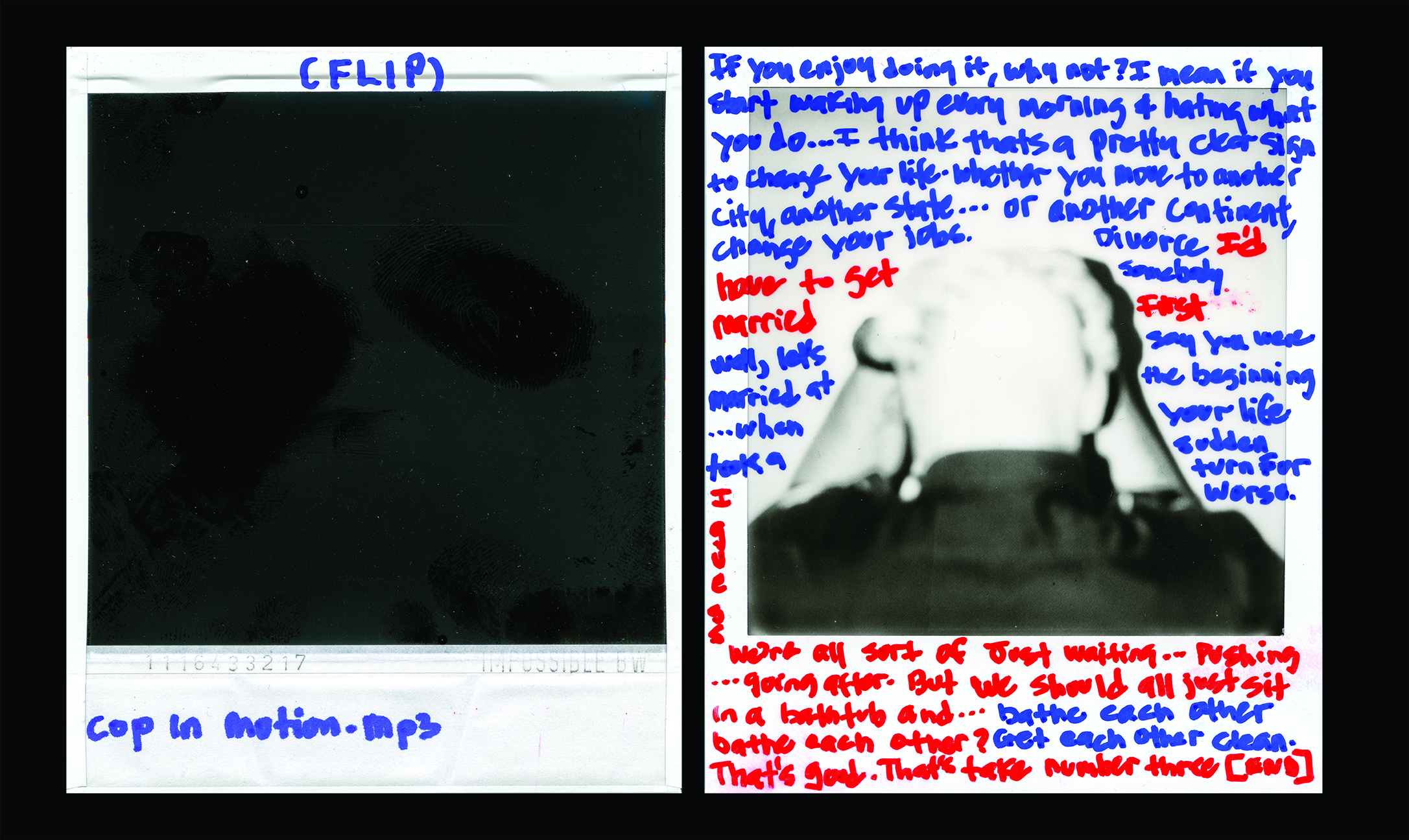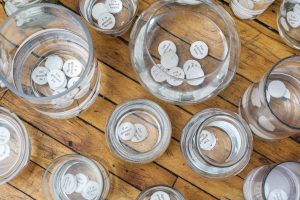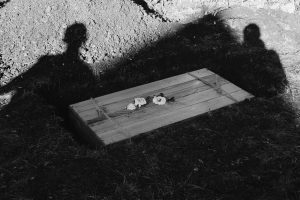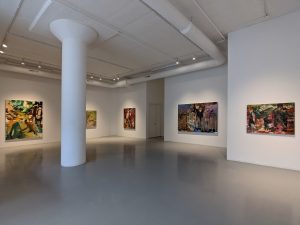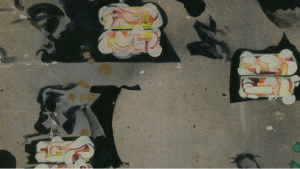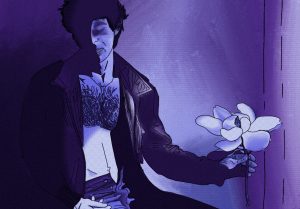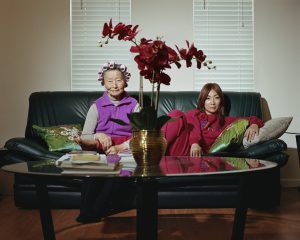“Intimate Justice” looks at the intersection of art and sex and how these actions intertwine to serve as a form of resistance, activism, and dialogue in the Chicago community. For this installment, we talked to Derrick Woods-Morrow in his studio about childhood romance, the inherent racism in photography, and how power operates in sex.
S. Nicole Lane: So let’s start with where you’re from. You’re from North Carolina, like me.
Derrick Woods-Morrow: Yeah! I went home last summer and there was a confederate parade. It was pre-Trump. It was right before the election or something, and it was 8 men with rifles and confederate flags walking up and down the highway shouting and marching. I live on the North East Side, closer to Brown Summit, so closer to the country. It’s almost like I grew up with that. That didn’t scare me. Charlottesville, which is considered mostly progressive is sort of scarier in a way, but that behavior [in NC] was like, “Oh who are these idiots, they’re probably the cousins of someone I went to highschool with.” You know what I’m saying? I grew up with the good and the bad.
SNL: Right. Whenever I go home to North Carolina and I come back here, I always tell my mom that I’m so happy to just go home—meaning Chicago—and feeling safe. Everyone else at home is like, “You live in Chicago, how can you live there?” I feel so much safer here.
DWM: It’s so interesting to me what people think of Chicago. I moved away fairly soon after graduating. I was home for a year; I got sick with Lyme disease, but then I moved to Boston and then moved Chicago. I had just landed and [my mom] was like, “You can’t move to Chicago.” I was like, “But I’m here. Your perception of this place is crazy. You gotta come to visit.” A lot of this violence that people are talking about is happening in very specific parts of the city—in places that I wish it wasn’t happening. And as much as I want to correct those communities, which I think is also extremely important—and I hate to give life to fake news—people talk about the whole of Chicago it is personified by this violence in ways I wish it wasn’t. I wish the media would give it a chance and see that Chicago is more than gun violence.
What I do like about Chicago is that people who live in Chicago, whether you’re from the South side or the North side, a bad neighborhood or a good neighborhood, whatever that means, everybody loves Chicago.
SNL: I know, so much pride.
DWM: There is a lot of Chicago pride. That’s a really good feeling. When summer comes people are outdoors.
SNL: Yeah! Can you talk about how North Carolina influences your work?
DWM: There’s a really nice, really seedy, part of me that loves to have tons of sex and be a dirty bird, and go down to the sex dungeons, and cruise outdoors where people can find me and fuck in places I shouldn’t. And then there’s this other part that longs for my childhood sexual experiences when it was really just easy to explore as a boy, you know, and not have to worry about all the political rhetoric. To be worried about political ramifications, to be a aware, to be …mature… is to be an adult, but none of that is really true. And so, a lot of times North Carolina comes into my work as a romance—a place away from adulthood. I think it’s romantic to try to build safe spaces for my childhood to exist with my adulthood.
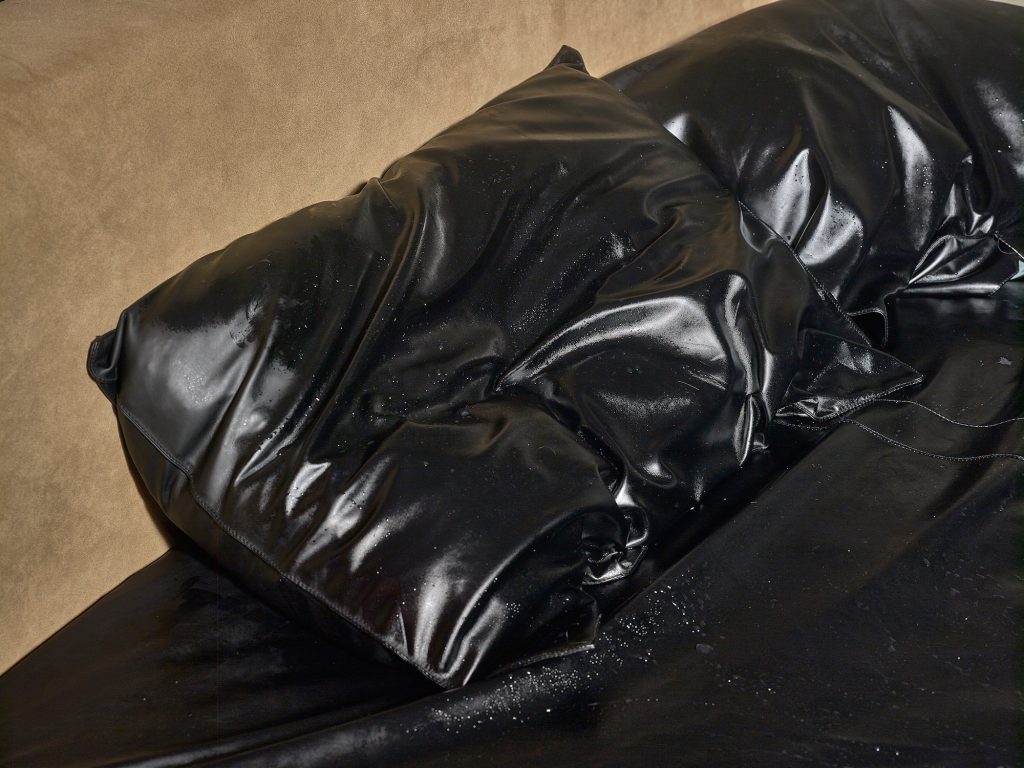
And then of course within the work, oftentimes male figures that I either had sexual encounters with or had really good bonds when we were both children come back into the work in some type of way. There’s a young boy, William, who I write this letterpress poem to that fades out, as you get to the bottom it fades into whiteness. And he identifies as straight, and of course is white, and will probably continue to have opposite sex partners for the rest of his life, but we have these sexual run-ins quite often when I go back to North Carolina. The childhood freeness I felt with him is written about. And then there’s a photograph of what I wish we could just do as adults, which is like ten hours of sex on rubber sheets, and we can’t ever really do that because of a time constraint, or because that would make him, in quotation marks “gay.” Or because all we have time for when we see each other is a quickie in a car, in a parking lot somewhere, in a park we both grew up playing in, and somehow it becomes two straight guys trying to help each other out, you know what I mean? I’ve actually expressed this disinterest, I’ve come out to him, and told him this is different, this is special, and yet I put myself in that situation because at the end the day, we’ve known each other since we were five. We’ll be doing stuff like this our entire lives, you know? And so there’s this weird push and pull. Even his boots are resin-coated and made into a sculpture for one of my exhibitions on top of a small wooden pedestal that is built like a child would build it, it’s got a nail sticking out of it. It’s not perfect by any means. It’s saying, “Why couldn’t we just be this young? Why can’t we return here again?”
Much of my childhood was wanting to be an adult so quick. And now I sound like my parents, but you grow up too fast, you know, enjoy it while you can. I think what’s even worse is that we all bought into the idea that we have these childhood dreams and then so what, the real world happens? You can’t follow them because of some fabricated responsibility, passed on to us by our parents. Why can’t we still have them? And I still want them. I still want to laugh and play, and play Pokemon like it’s 1996. And I sort of curse all the nine-to-fivers who tell me that I don’t work. I work sixteen hours a day. The studio is work, maybe it’s play, maybe it’s both, but I feel the weight of what I want to do with my practice and it feels like work. I’m sitting around thinking in the studio more than they’re ever in the office, but they’re making fifteen times as much money as I’m making, you know?
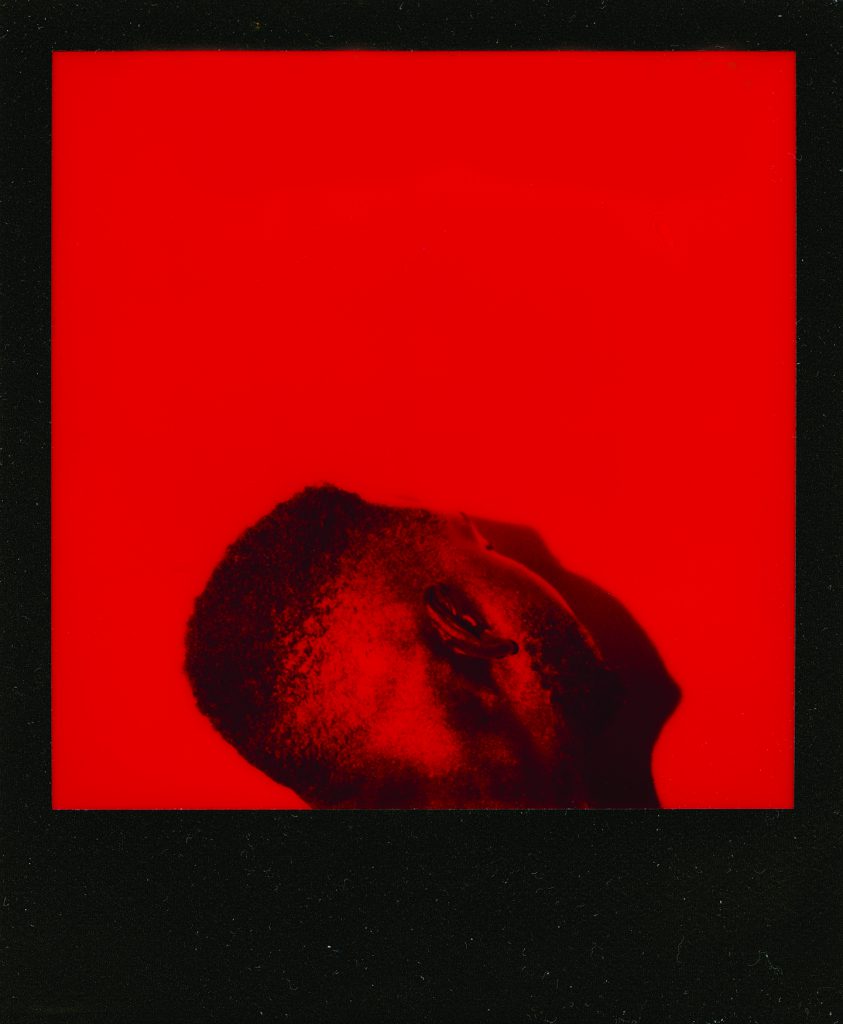
SNL: Totally. So you moved to Chicago, you came here for school. What did you study? Tell me all about it.
DWM: Well, back in North Carolina I picked up this job in photography, and it was horrible. I was taking photographs of kids with this J.C. Penney-ass type of place. I literally had fifteen hundred dollars. I bought a car the day before, and I left. I drove to Boston, and I just left North Carolina, and said I’m going to go and try to get to grad school, and I ended up going and getting into MassArt. And then the opposite sort of happened. I was working this job in education research when I was getting my post-bac at MassArt and I was going to be financially stable but I wanted to really do art for some reason, or maybe for no reason at all. I had this impulse to do it. I tell myself now to be more impulsive. I think I’m much more confident now but for a long time I struggled with just being confident in the decisions I would make. It still takes a long time for me to make a really hard decision. I didn’t believe it was possible that I could get into art school. When I grew up North Carolina, if you couldn’t paint or draw you weren’t supposed to be in art class, I didn’t even know there were other possibilities —
SNL: —Yeah, when I was growing up and in school in North Carolina, everything was very craft oriented.
DWM: Yeah, I still can’t paint or draw in a traditional sense, or however people choose to define them today. And so it was a pipe dream. Then I got into SAIC. I still don’t know how, but I did. And then I started school and I struggled through school. I struggled a lot through school. I was in the photography department and really struggled with the department’s strategy around seeing work of color, or work from artists of color. The positioning also, again because I think artists of non-color—that’s my new term, or people of non-color—their work should also be racialized in some type of way. If black is a color white is a color, right? In a world where blackness is normalized, whiteness shouldn’t exist. In this way I feel like school asked non-color students to only make abstract art work and then artists of color would always just supposed to be making work about their struggle at home with their fathers or their mothers or something stereotypical. This thinking is very problematic in an academic space.
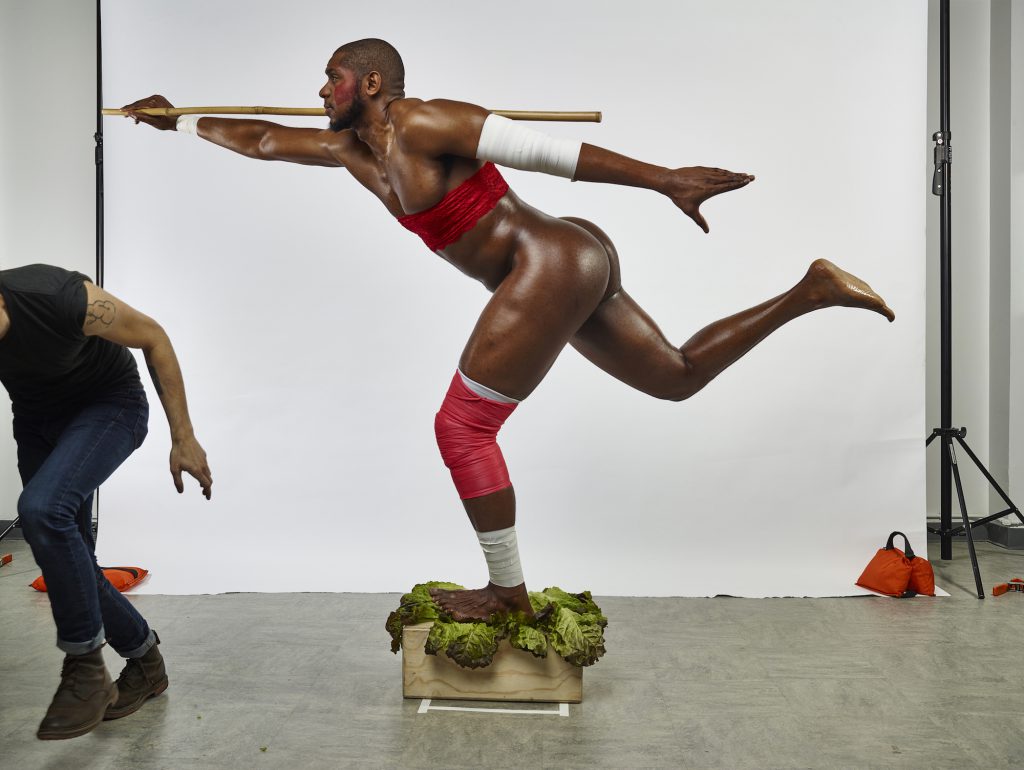
I had made this this body of work where I was embodying Grace Jones and Kim Kardashian, and Saartjie Baartman (Sara Baartman). And people kind of went nuts, they really liked it. It was the first time, I think, people really liked the work in a way, but then I wasn’t happy with it, it all seemed too easily consumed. People saw Grace Jones and of course my ass, they smiled and laughed and walked away from me and everything I was trying to say.
SNL: What weren’t you happy with exactly?
DWM: Performing in it, in a way. It’s not so much the performance but putting the performance on display for people to look at. Now albeit, these were very big prints, so it was impossible to miss my body in them, and I think if they were small prints I still would oftentimes feel the same way. My semi-nude, if not nude, body performing as Grace Jones and Kim Kardashian: that was the foreground. In the background of this work were the ways in which photography racializes bodies, the ways in which the photograph itself is inherently racist.
For so long in photography you couldn’t even expose for certain skin colors. Kodachrome was balanced for white skin only until the 80’s. In the aesthetic value of my photographs were things like the Kodak color wheel in the background, all of the things used to frame and compose the photographs are actually left in the photograph so that the white backdrop doesn’t roll out of the way, and the clips that are supposed to hold it together sitting on the floor of the photograph, and the photographic assistant is still in the photograph. I wanted it to be a critique of something that never really got to be a critique because it never, for me, got past my body being on a pedestal. I had to decide if I was going to blame myself for that, because I did position myself there, and how I was going to mediate that space. In the meantime, still dealing with that, I’ve still been on a hiatus in general from putting my body directly on display, and in a way, put my body in harm’s reach by performing in these types of things.
In another body of work I build contracts with predominantly white men but with men in general, where in order to have sex with me, they must give me full access to the archive of images in their cell phones, and I use their images to make my work. I was thinking about how in a way working like this is putting myself directly in the space in which I’ll be objectified, but if you do, you must give me something, and I can take it… I can take anything. There’s literally a contract written with a lawyer. You must give me whatever I want from your phone, maybe your social security number, maybe a photo of someone you fucked last night, and you’re not allowed to say no. I’m still performing through the lens of objectification, you know, still performing in the work but hopefully it puts the work more on display and less me on display, or does it?
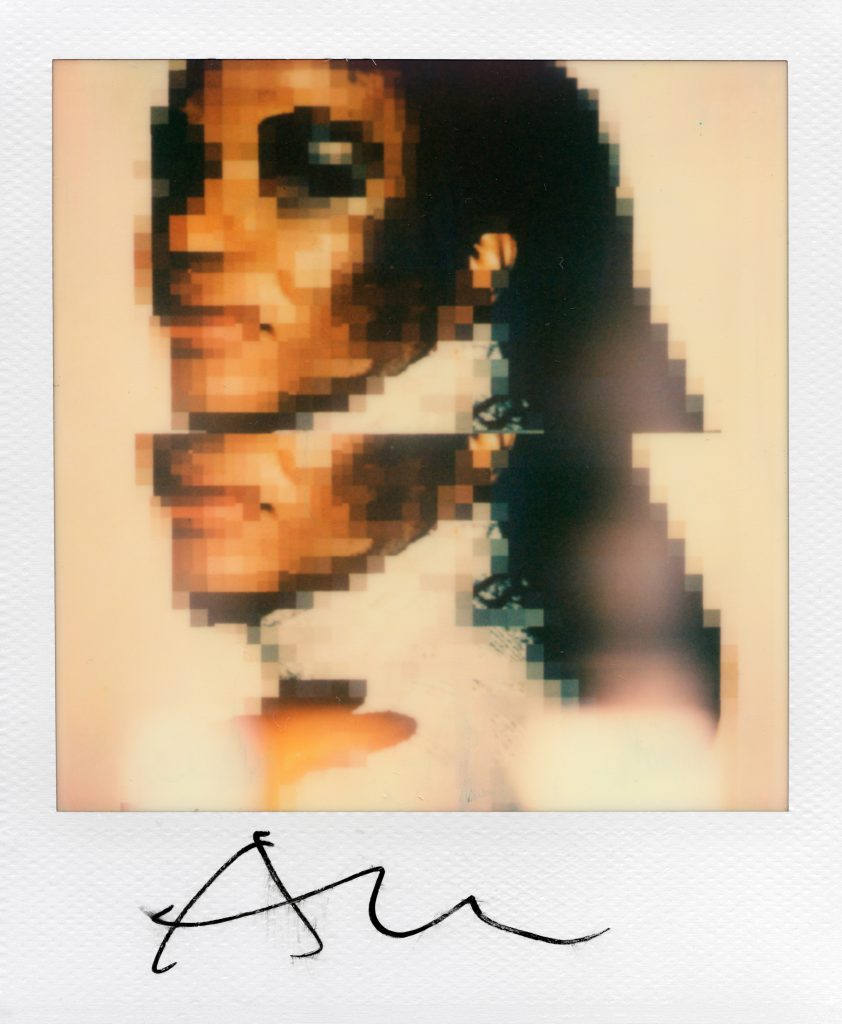
SNL: Your work has these power dynamics or sexual dominance that comes along with desire. Can you talk about how dominance plays a role in your work? Is it something that’s important?
DWM: I think power plays into my work a lot, and I’m always considering the way power functions in the work. But in the course of sex, I think maybe the biggest power for me is how seduction and desire go back and forth—looking at who is seduced by who and how power operates there. Most of the pieces that are installation pieces within my practice are asking the audience to be seduced into doing something. There are pieces that have polarized glass on them that you can only see if you were to stand directly in front of them, but I don’t put them next to any height. I put them pretty much on the ground, so you must get on your knees in front of everyone if you want to see this video. Is it shiny enough, is it elusive enough? What makes you want to do that? How can I use the power of seduction to get you to do that? Will you do it? It’s something I’m always wondering. What will people do in order to gain knowledge in the work? I feel so powerless in the world we live in. I mean I don’t want to reduce it to race but I can’t help but reduce it. I am a large black man, right? People say, “You have all this power,” and I don’t have any power.
I was thinking today in the car: “What does it mean to be doing something? To be a hypocrite, to be a paradox and actually be doing something in this world?” Getting deeper into this work, we’re talking about sex work, prostitution, rentboys, call boys, all of it. I’m basically prostituting for polaroids. Like does it even have capital? Can they be sold? Does anyone want them? And more importantly is this project important to anyone but me… Like what are people willing to give up for sex, you know? So it’s like I know what this sexual experience means or could mean to you but to me the art is in the negotiation, the performance, and not so directly in the final product.
I think sex can be quite fluid as well. So I think power is a huge, huge aspect of specifically this work, and in a lot of the work. I mean it really is all about sexual desire. Who are the bodies that we desire, and why do we desire these bodies, and what for? Because I have my own desires and some of them, I wish I didn’t have —like my occupation with furry, bearded bulking bodies deemed masculine, often white. I’m fixated on what constructed me to believe that this thing could be hotter than this other thing. Constantly thinking to myself, “What constructed me to fall in love easier or fall quicker for these physical attributes?” Even though now I know how dangerous that fall can be… For a trait that I don’t even agree should be any better than another trait. Growing up I didn’t see black bodies, trans bodies, queered bodies on TV. I wish I had. We are really just constructions of our stimulus and outside of innate biological systems, so much of our sexual attraction is just constructed space. I’m wondering if I can constructed my art to function in the same way. Can certain traits seduce you? Can it make you say, “I’ll get on my knees for Derrick’s work.” Serve me. Nah, fuck that, serve yourself.

SNL: Were you doing photography at all before going to school?
DWM: It goes back as far as my undergrad, I played college basketball, I wasn’t out then and things were very different, but we’re sitting here, I’m dressed currently in a crop top that says “black no cream no sugar” in technically fetish leggings, but I play basketball in them go figure. I have definitely been conditioned to be a jock, and now I try to twist it up as much as I can. I feel really comfortable, maybe more comfortable in the compression tights, and the shorts, and the sneakers, but the crop top is like the icing on the cake. Its a lot for me. I know it’s just a shirt but it’s a lot for me. I think that kind of jars me and jars other people when they see someone my size wearing something like this—something I never thought I would do.
Anyway, I found that a darkroom was the best way to escape my teammates when I was in undergrad. I took art classes and I was this weird art college basketball player, and it wasn’t much of an art school to begin with. I went there on the promise of getting an art education but it was very much drawing nude female bodies and flower watercolors, which is an art form, but it wasn’t in depth or conceptual or contemporary in the way that I think about art now, and the art I want to make. The cool thing was, I could hideaway at four o’clock in the morning and go down to the darkroom, because all of us in the class had the key, but everyone was asleep except me. To this day I don’t sleep much, and I would just be up all night and develop film. That’s when I first fell in love with photography, and then I got to grad school fell out of love with it quickly…
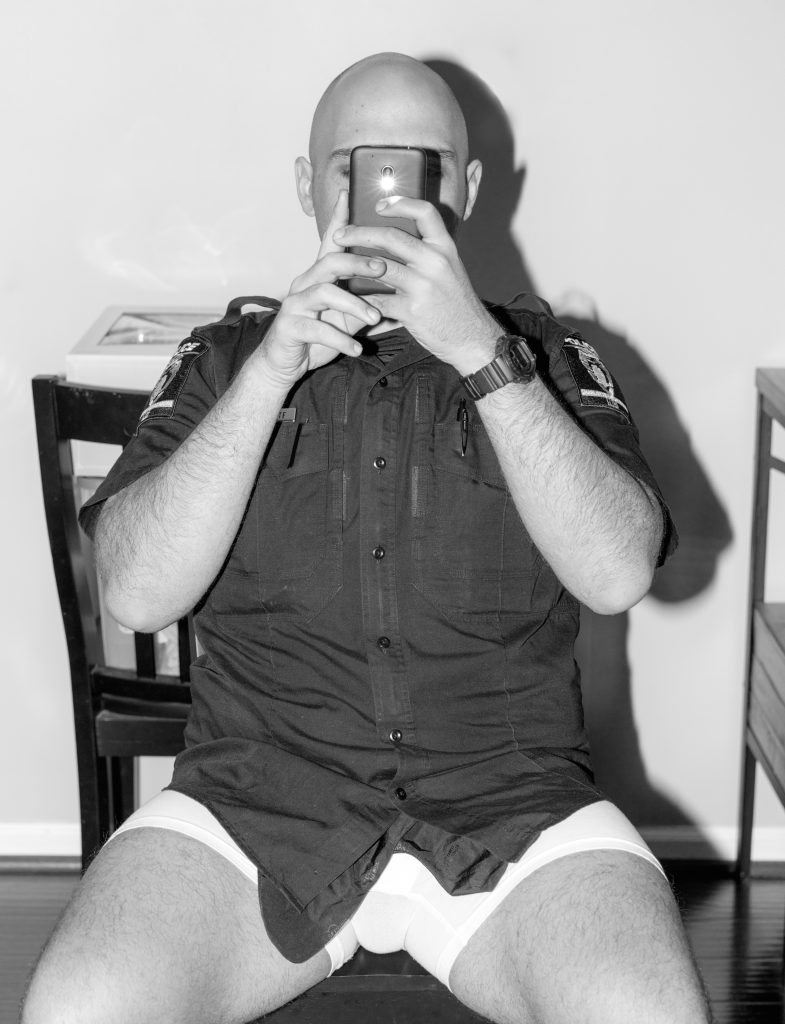
SNL: And I feel like video or film is a natural progression, you know, when you realize that photography isn’t giving you what you want.
DWM: It was so romantic in the beginning. That’s a book I could write, or some type of poem I could write about really being able to sneak away, like this closeted basketball player sneaking away to find his sexual romance in developing photography, like that’s this whole book, you know?
The ceramic sandcastle sculptures I’m building right now, are a departure from photography, and I’ve been so much happier just building ceramic sculptures with my hands. More happy than I have been behind the camera, and so I think I’m moving. I think photography is a tool to convey something but I think my practice is becoming more fluid, very densely multidisciplinary. And who knows in a year I could be painting and drawing, which I’m scared to death to do, but it’s okay because if I want to do it or if I fall in love with it in a way, then bring on the new romances.
SNL: And that’s what being an artist should be. I’m always skeptical of people who just stick to one medium, or two. There are so many things you can learn, obviously a lot of it’s scary, a lot of it’s difficult and out of our comfort zone, but why not?
DWM: Why not! I think I could take a good photograph, I hope so. But why not struggle to make ceramics? I think I would rather be uncomfortable. Knowledge is gained when you’re most uncomfortable. Like when I wear a crop top and I naturally would just be in a tank top. It’s teaching me the things about masculinity that I need to deconstruct for myself. But to go into a studio and be like “Oh I’m going to build ceramic sculptures today with no training” is crazy! Like why would you ever want to do that, right? I don’t know if I’m trying to make it harder for myself but I am sort of trying to challenge myself to denounce a lot of the easy pitfalls. Be uncomfortable. I’m constantly experimenting, constantly throwing stuff at the wall and seeing what sticks, and maybe nothing ever sticks, but I get to keep trying and as long as people keep giving me opportunities I’m okay. And if they stop giving me opportunities then maybe not. Sounds scary and right now I’m feeding off of that to make what’s coming next.
SNL: And those ceramic works—what are they of exactly?
DWM: I’ll say that as I keep continuing to destabilize myself, I hope I get smarter. Embedded in the work is the idea of going into white spaces and trying to fuck them up, but to be honest that can be very taxing and unhealthy. In the sandcastles, I needed another space of my own, for my sort of wellness. So they are sort of these fictional sand castle monster houses that are like this weird safe space, but fraught with tons of holes and cracks and loops in them. They’re weird and fun. They’re built out of the clay from my childhood playgrounds—North Carolina red clay, it only comes from the tip of Georgia and North Carolina. It’s impossible to get. I had to contact all these NC legislatures. It turns out they only really use it for the bricks. I called back home, maybe 25 miles from my home. A brickyard was super kind and donated the first hundred pounds, gave me a super good rate on the on the rest and told me I could have it whenever I wanted —I call and order a few hundred pounds every few months…
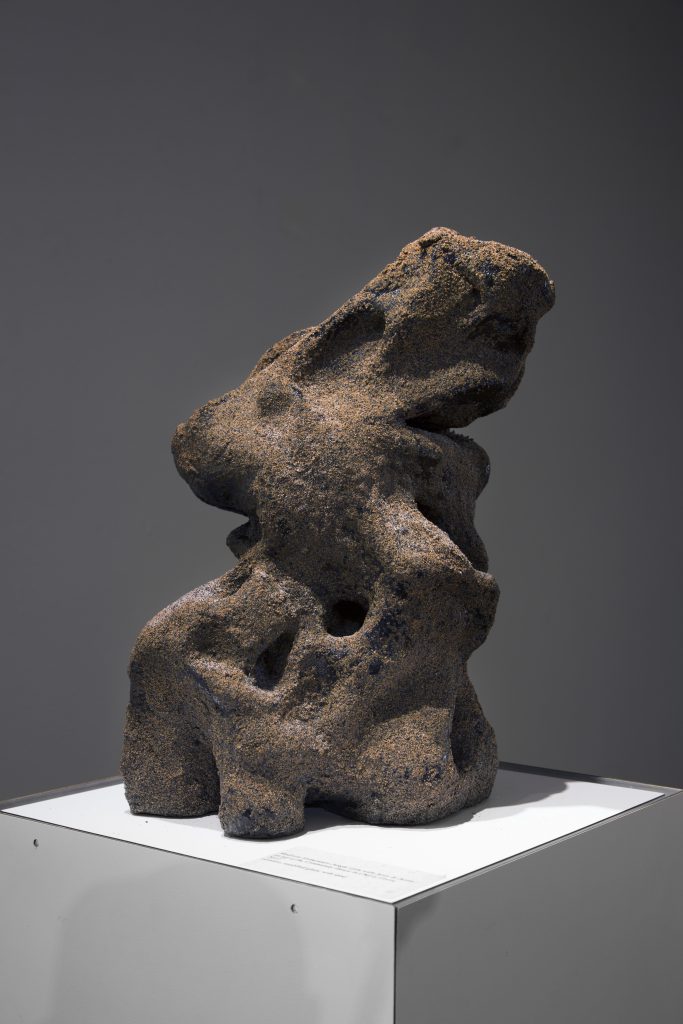
So yeah, I’ve been making the pieces out of the clay that I rolled around in as a child. And it comes as dirt, which is great, so I actually have to put the water in it, blend it, let it dry out, and then start pounding it to death so that there’s no air bubbles, you know.
I did the Fire Island Artist Residency last year and had a blast. Fire island is sort of known as this gay utopian oasis. Actually it’s quite dystopian. I’ve technically been stealing the sand from it and paying queer kinksters to do the same and send it to me via USPS. Fire island’s Meat Rack, which is a magical forest in between two sides of Fire Island is considered to be the sandbox of gay men. A place I went to have tons of sex and just play, be free, be black and be fucked. Historically, a place many white men have gone to do the same. I couldn’t just reclaim the space for my black kinky queer self, so I literally built a new space for myself.
SNL: Can we talk a little bit about how your photography works as an installation?
DWM: I guess my work is installation experiential-based. Oftentimes I’m really interested in how people come to the work and come to understand the work. I think some of the work is aesthetically pleasing, and since graduating grad school, I often push away from direct representations of the black body in the work and more into representations of how I personally perform in the work. At least in an exhibition space or installation opportunity, I trying to position people to experience the work in a certain way. There’s an object at the Leather Archives Museum that is basically a chair gloryhole. But at the height that it’s sitting, you’d literally have to get down and fuck it. Like you couldn’t just stand and sit idle, you know? In another sort of gloryhole-esque piece of mine, there was a glass piece I built in grad school. It’s a freestanding piece of glass that was less than a quarter inch thick, and so it was meant to fall, break, and cut your head off. It had this hole and it was mirrored, and so unassuming people checked their makeup in it. Like what? People are checking their makeup in my glory hole.
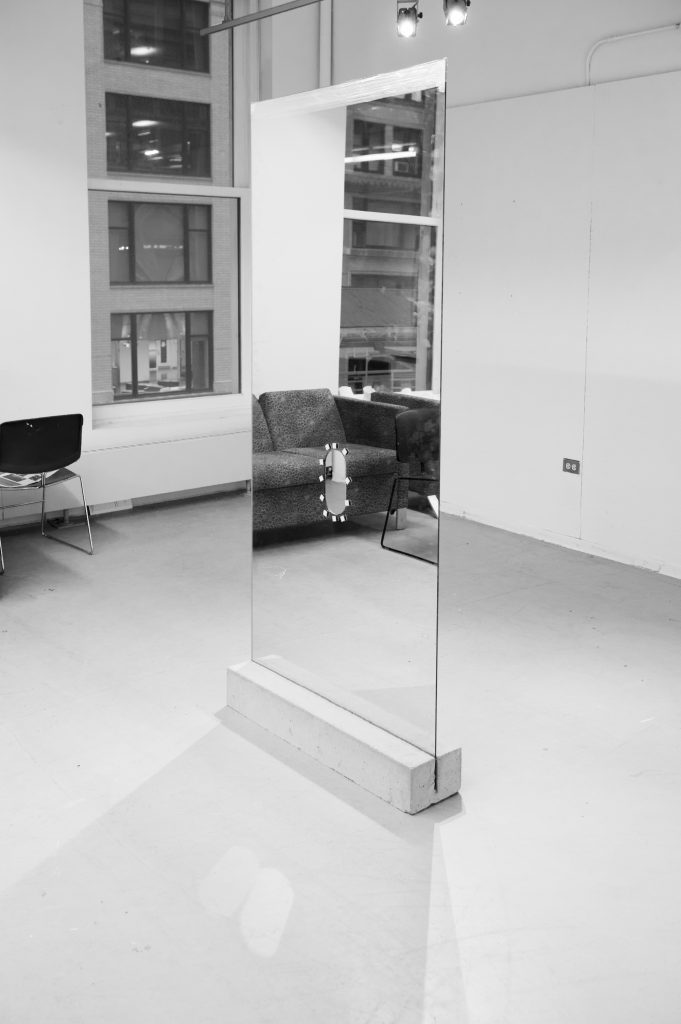
I have this particular film that I’m working on. It doesn’t perform as well if you aren’t immersed within it. It needs to be seen in a closed space, and so my beginning thought about that is two people sitting close together, maybe with headphones, in a bathtub, because that would be a similar setting where the film’s interview, in which I bathe a police officer and interrogate him, takes place. Doing so may just put them where I was. In a very weird head space for sure—maybe sort of immerses you in your own head or could immerse you in my head, but this is at least like a very early throw in the dark about how image and installation can work together.
SNL: In the film, currently titled, “The Roach is Coming,” can you discuss the inclusion of two white twin boys? And your choice to keep in the director’s voice telling them how to perform?
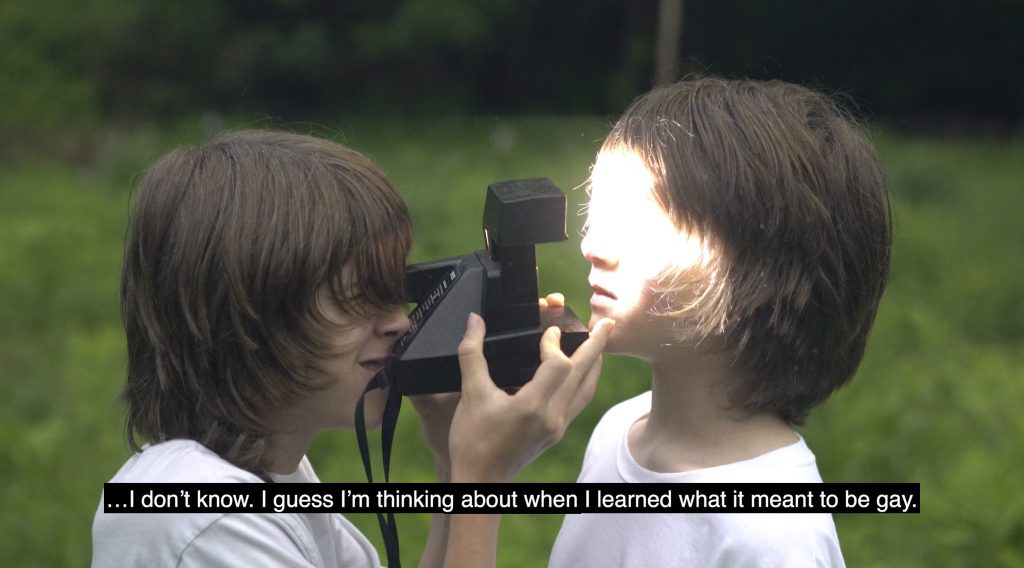
DWM: I’m teaching at UIC right now and I went to critique last year, and we had this critique of Liz McCarthy’s work. She’s amazing, and is such a kind generous person. She helped open the door to ceramics for me and during her critique, we got to this point where everyone performing for her work was white. There was a point at which Nate Young suggested: why are we not seeing white bodies as racialized bodies? Cauleen Smith said something similar in response. We commonly see them as normal bodies. Early on I thought when making this body of work, “Why not use white twins, or I could use a white boy and a black boy, right? But why?” Black filmmaker directing whiteness in its adolescence to personify a white cop and a black man in a bathtub with me bathing him. And it kind of hit me, that conversation popped in my head, and I was like, “Why can’t I make white bodies perform for me, and why are they not racialized?” That was sort of sitting in the back of my head the entire time making the film. The decision for the audience to hear my voice command them is very important to the work. The process, even the editing, was very intuitive and yet very new because it’ll be my first short film—my friend Aymar helped me—I put pieces into place, some pieces that could logically fit, and many that didn’t logically fit and started to build it out, really, I just wanted it to feel good, for the film to be felt by the viewer and I hoped that it somehow fit together. I continue to rework it, but each time it feels better and should be ready by March.
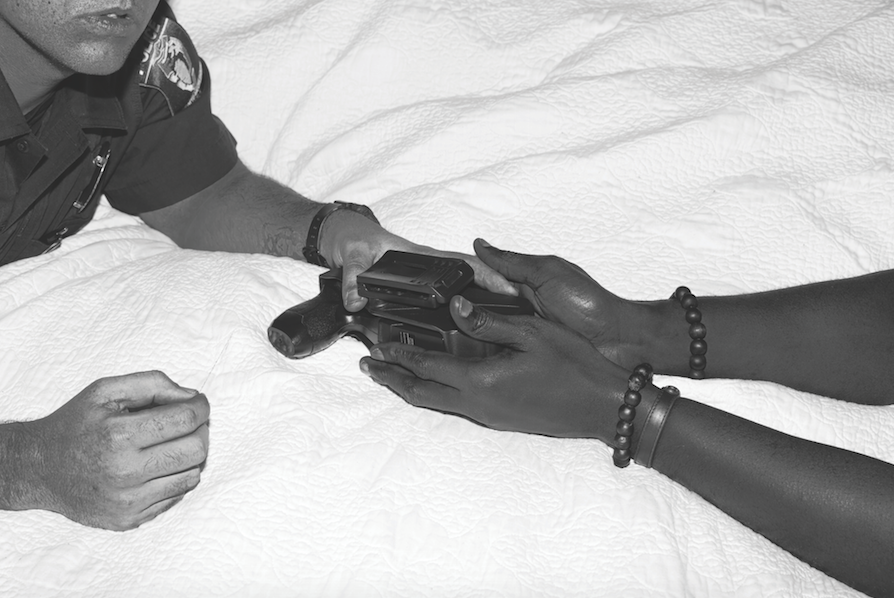
SNL: Do you see your work as political activism?
DWM: At the dinner table we talk about glory holes when I go home, like for dinner with mom. In a way it is very much like an activism for me to be so vocally sexually charged.
And specifically with the artwork, I’m responding to police brutality in my own type of way. Most of the work is an outlet for me to deal with things, and cope with the things happening around me.
I currently live on the north side of Chicago, which is very white, and within that scene, the gay scene is ninety to ninety nine percent white. I go into a space just ready to fuck it up. Just the crop top, and just enough ass to be like, “I’m topping the top tonight.” And I enjoy that type of thing and I consider it a type of activism, even within my own community of people of color. I mean people of color were the people who were very drastically indoctrinated with Christianity. People of color, gays of color, men of color who sleep with other men are dealing with a lot right now. I’m dealing with a lot, at times things feel really heavy. My partner is Jamaican and we are open, but I’ve met other men of color and often times if they are sleeping with other black men then it has to be like this perfect monogamous type of relationship for them. I used to be the same way, so much has changed for me. My partner and I, we’re poly and I might have a boyfriend on the side, he might have several lovers and then I might have a partner or a lover here or there as I float around the USA, men, transmen, transwomen of all colors, and then I have a hundred sexual interests that my partner and I love to enjoy. My kink, ya know? In that way my openness is fluid and verbal and its own type of activism.
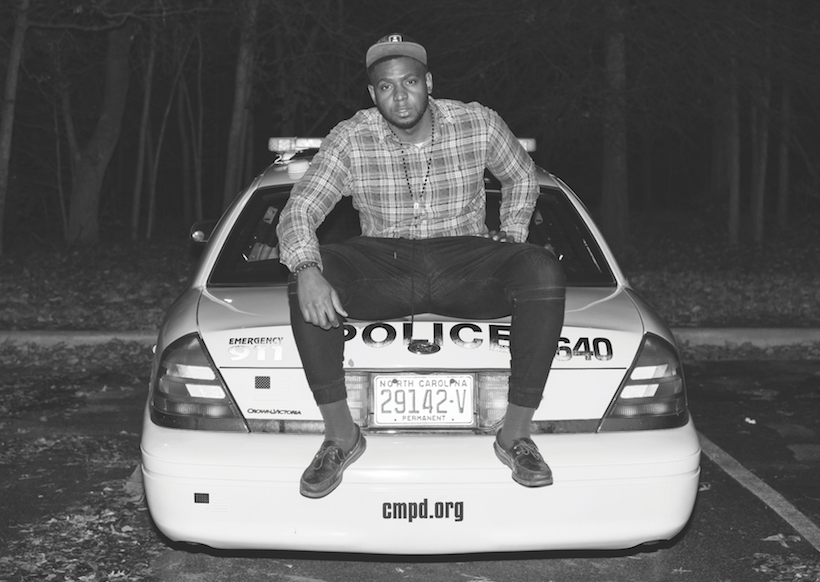
I would say my lifestyle is negotiated through the art, because I see them intertwined as much as I don’t just need people to see and consume photos of my black body without investigating the rest of me. Even my nude selfies are very much about twisting a type of sexual activism for me. I’m thinking there are a lot of easy ways to make works—maybe not easy, but very direct ways—to make work about the police. But really thinking about what the sexual relationship between me and this young boy when we were that age, and how we’re so diametrically different and still the same years later, it made me want to make an artwork that hopefully is way, way, way more dynamic, and also very telling about how serious this is to me. That when I was young I played on the playground, had sexual experiences with a boy, who grew up to be a police officer, from my hometown, and how we hadn’t spoken in 15 years until I reached out for this project and how I needed to leave NC, because I had to…
And how if I had remained, God forbid in North Carolina, I could have grown up to be a cop too.
Featured Image: Courtesy of the artist. Two polaroids are presented with the left hand side featuring the back of a polaroid an the right hand side featuring a black and white image of the back of a cops head. His hands are on his head and blue and red text is written around the frame of the subject.
 S. Nicole Lane is a visual artist and writer based in the South Side. Her work can be found on Playboy, HelloFlo, Rewire, SELF, and other corners of the internet, where she discusses sexual health, wellness, and the arts. Follow her on Twitter.
S. Nicole Lane is a visual artist and writer based in the South Side. Her work can be found on Playboy, HelloFlo, Rewire, SELF, and other corners of the internet, where she discusses sexual health, wellness, and the arts. Follow her on Twitter.
